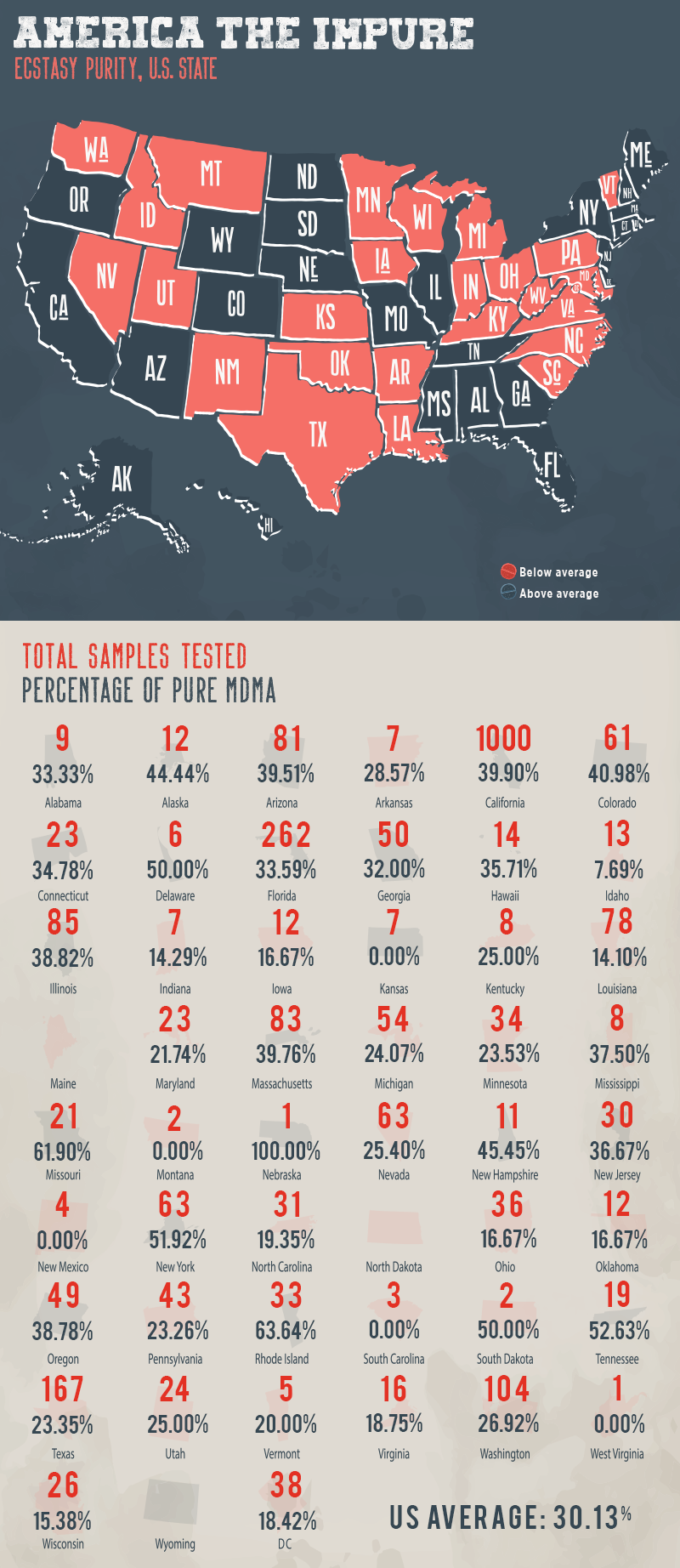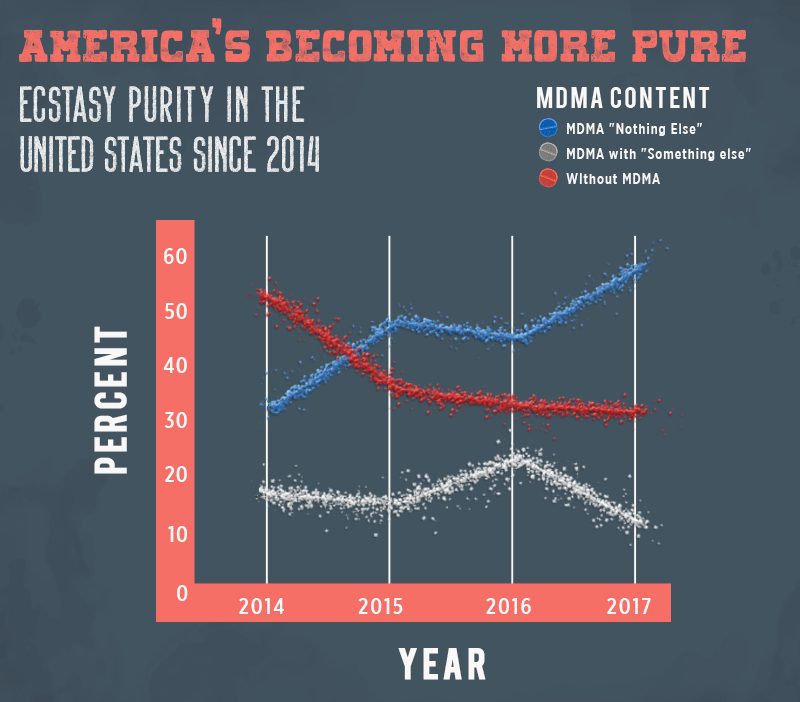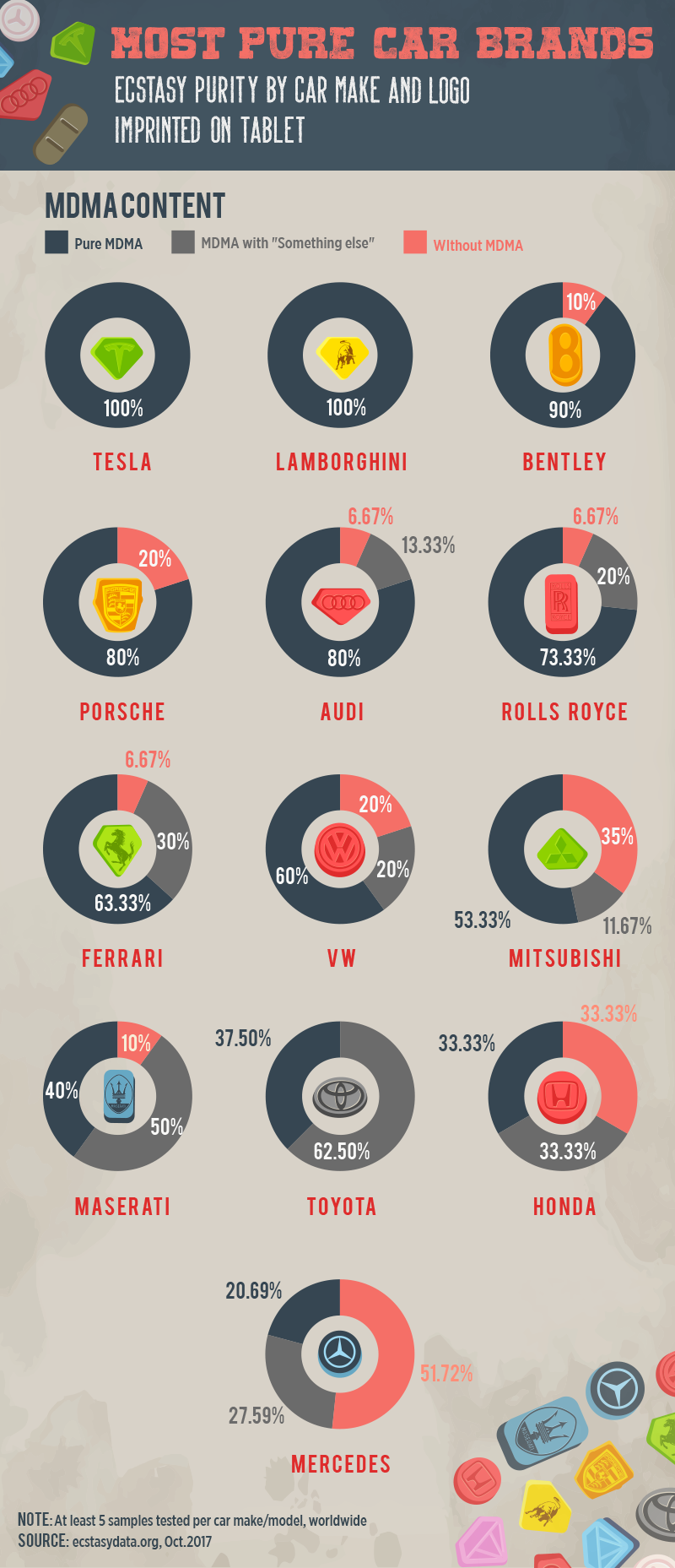
Updated April 2, 2019
It may sometimes be referred to as the “love drug” or the “hug drug,” but ecstasy around the world is getting stronger, deadlier, and even more popular than ever, leading many to struggle with ecstasy addiction.
In reality, pure ecstasy should include only one ingredient: MDMA. Instead, drugs today have been filled with various toxic substitutes including amphetamines, piperazine, and various other chemicals undetectable at face value.
To learn more about the inconsistent purity of ecstasy on the market today, we utilized data from the independent testing program EcstasyData.org, which regularly collects and reviews new batches of the drug to test for new and harmful substances. Impure ecstasy can cause serious health concerns for those struggling with ecstasy addiction. Want to know which states have the highest volumes of impure ecstasy in the U.S. and what you might be able to do to identify these sometimes lethal additives? Read on to find out.
Counterfeit Consistencies
On average, less than one in three ecstasy pills purchased or produced in the U.S. are composed of pure MDMA.
Despite common misconceptions that drugs in America marketed as “Molly” are considered pure MDMA (a drug originally developed as a medication to help treat depression), few actually are, making it a tricky situation from users who would benefit from ecstasy rehab. In some states across the country it’s even less likely that drugs being sold as ecstasy contain even a fraction of ingredients users may be anticipating. In 26 states, our research revealed that drug samples were even less pure than the national average.
In Kansas, Montana, New Mexico, South Carolina, and West Virginia, despite analyzing multiple samples that had been sold as ecstasy, EcstastyData.org didn’t find a single substance that contained pure MDMA. Because Molly has become ever more popular among teens and first-time users, and Molly’s use increasingly widespread, the use of unidentified synthetic chemicals has the potential to become even more dangerous. According to the DEA, law enforcement officials have discovered 200 new compounds in drugs marketed as ecstasy since 2009 and 80 since 2012 alone.
Unseen Risks
In 2013, drug samples tested by EcstasyData.org revealed that drugs being sold and marketed as “Molly” or ecstasy were more likely to contain zero traces of MDMA than to be pure or even a mixture of MDMA and other substances. Since then, the number of pure MDMA samples has been on the rise.
Today, ecstasy pills, liquids, and tabs aren’t just more likely to be pure – they’re generally stronger too, making ecstasy rehab even more necessary. Research has shown that today’s ecstasy is roughly five times the strength of similarly branded drugs in 2009 – occasionally creating a lethal dosage. While pill testing kits have become a popular resource at music festivals and clubs where ecstasy is more popular, these kits won’t help users identify the strength level of MDMA present in their drugs. While previous years saw ecstasy that was often so diluted with unknown chemicals that true MDMA was less likely to present, today’s concerns have become even more difficult to detect in advance.
The chart above shows the percentage of MDMA by the pill color: No MDMA (red), Spiked MDMA (white), and Pure MDMA (blue).
Visual Cues
In an effort to help protect men and women who choose to consume drugs like ecstasy on a recreational basis, some organizations have stepped up to help reduce the dangerous lack of transparency around drug purity and strength levels. While detecting the concentration of MDMA in an ecstasy pill is more difficult, testing for its purity has become a more mainstream occurrence. Sadly, many of the dangerous substances that ecstasy is often cut with (to reduce costs or increase production rates) have been linked to rapid heart rate, anxiety, sleep disturbances, and even death, severely hindering ecstasy recovery.
According to EcstasyData.org, our research revealed purity levels of ecstasy in the U.S. could often be determined by the types of color and symbols used on the pills themselves. Nearly two in three ecstasy pills that were peach-colored have contained no traces of MDMA, followed by roughly half of black and orange pills. Based on the data we surveyed, off-white and gray pills were the most likely to contain the highest percentages of pure MDMA, though as some law enforcement officials noted, in a 2013 article in HuffPost, “the ingredients are constantly changing” and there are “no ‘good batch[es]’ of Molly.”
Reading the Signs
Like the colors used to differentiate or market ecstasy, logos and symbols aren’t uncommon either. Those who would benefit from ecstasy recovery will often be familiar with many color and symbol combinations. As our research found, trends among car brands found embossed on ecstasy pills could contain a hint as to the purity (and strength) of the drug.
Samples containing two logos in particular (Tesla and Lamborghini) were exclusively linked to entirely pure traces of MDMA. Internationally, studies have revealed drugs with the Tesla logo may be pure, but could also contain dangerously high levels of MDMA. While the average ecstasy pill may include anywhere from 80 to 120 milligrams of MDMA, some Tesla branded samples have been found to contain more than 230 milligrams of the substance.
Pills with the Mercedes, Mitsubishi, and Honda logos were often the most likely to contain no traces of MDMA, while Toyota and Maserati pills were more commonly found mixed with other substances rather than pure MDMA.
Heroes Turned Deadly
In the epic showdown between Superman and Batman, drugs embossed with these two iconic comic book hero’s logos may be taking lives rather than saving them.
In 2015, three men were found dead on New Year’s Day as a result of ingesting high traces of PMA (para-Methoxyamphetamine) they believed was ecstasy in pills designed with the Superman logo. One of the less common substances linked to impure ecstasy samples, PMA can be up to 10 times more potent than MDMA but may take longer for users to feel its effects. According to our research of samples from May of 1996 to October of 2017, ecstasy adorned with the Superman symbol was less likely to contain pure MDMA when compared to drugs with the Batman or Warner Brother’s logos and nearly one in three pills had no MDMA whatsoever.
With no medical benefits and a high potential for misuse, ecstasy can be equally as dangerous in pure forms as it is when cut with other substances. After the effects of the “feel good” neurochemicals dopamine and serotonin have worn off, users may begin to experience anxiety, agitation, dizziness, and nausea. For days and weeks after use, a person may even have feelings of depression, memory lapse, and confusion that leads them to want even more of the drug to help correct the chemical imbalances left in its wake.
Signs of Ecstasy Abuse
Chances are that if you’re already very familiar with all of the above iterations in pills, either you or someone you love has been using the love drug Ecstasy— in which case, you need to know that overuse of Ecstasy can lead to dependency and even death. The following signs of Ecstasy abuse may indicate that you or a loved one could benefit from professional advice, diagnosis, or treatment:
- Heightened sensory perception
- Dilated pupils
- Emotional dysregulation
- Decreased anxiety or depression
- An inability to feel pain or decreased sensations of pain
- Unnaturally high and long-lasting energy
- Desire to touch or be touched
- Changes in sleeping habits
- Periods of prolonged wakefulness lasting for days
- Confusion
- Paranoia
- Impulsivity
- Teeth clenching
- Muscle tension
- Dry mouth
- Promiscuity
- Thirst
The Long-Term Dangers of Ecstasy Abuse
Long-term use of Ecstasy poses greater dangers to your brain and body. Research published in the journal Clinical Correlations has found that prolonged MDMA use can cause serious brain damage: long-term users may experience difficulties with cognitive decision making, executive processing, reasoning, and problem solving; their emotional intelligence may also be impaired as a result of Ecstasy.
The brain isn’t the only organ of the body susceptible to severe Ecstasy-related damage. MDMA can cause permanent damage to your nerves and other vital organs. As illustration, consider this lengthy list of long-term effects attributed to Ecstasy:
- Psychosis
- Nerve degeneration
- Memory loss
- Depression
- Anxiety
- Kidney failure
- Hemorrhaging
- Cardiovascular collapse
- Convulsions
- Death
The takeaway: that anyone who reads this piece and is an Ecstasy user should throw away that stash of pills, pick up the phone and get professional help.
Getting Help for Ecstasy Addiction
Anyone who suspects they have an addiction to Ecstasy should first consult medical professionals for advice or medical diagnosis before attempting to detox on their own. Suicidal thoughts, behaviors, and actions have been known to occur during Ecstasy withdrawal. So may other complications— especially in the case of a longstanding Ecstasy habit. For these reasons, a medical detox is always strongly recommended as the first step towards recovery from an Ecstasy problem.
If you or someone you love needs help with ecstasy recovery or substance abuse, FHE Health, a premier rehab facility, is here to help. Our patients come from all around the country, including South Florida. If you’re looking for a sober living program or a drug detox center in Florida, consider us. We at FHE Health believe in communication in substance abuse recovery. With world-class inpatient and outpatient treatment plans, our team of neuroscientists and psychologists are available to help pinpoint exactly where addiction impacts the brain to help customize your care and help you down the path of ecstasy recovery. Our treatment process isn’t just focused on the substance— it’s focused on you and the path to recovery. Visit us online at FHERehab.com today to learn more.
Methodology
We pulled ecstasy purity data from EcstasyData.org and looked at purity by a variety of different factors, such as color and logotype, and further broke down overall purity by state and by time.
More of our Studies
Millennial Drinking Trends – A Look at Millennial Drinking Culture
Thoughts on Drug Addiction – Surveying Attitudes Toward Different Drugs From Users vs. Non-users

Extra Life – Video Game Addiction Statistics

Sources
- https://thetab.com/2016/05/11/ecstasy-getting-stronger-need-know-89672
- https://www.theguardian.com/society/2016/may/31/ecstasy-comeback-european-drugs-survey
- https://www.drugabuse.gov/publications/research-reports/mdma-ecstasy-abuse/what-are-effects-mdma
- https://abcnews.go.com/US/story?id=95562
- https://www.cnn.com/2013/11/22/health/9-things-molly-drug/
- https://thetab.com/2016/05/11/ecstasy-getting-stronger-need-know-89672
- https://www.pe.com/2017/04/23/this-group-smuggles-drug-testing-kits-into-coachella/
- https://metro.co.uk/2016/12/27/the-grim-cutting-agents-that-drugs-are-cut-with-6232901/
- https://www.huffingtonpost.com/2013/09/05/molly-overdoses-college-officials_n_3869854.html
- https://www.inverse.com/article/20647-mdma-ecstasy-pills-tesla-logo-str
- https://www.theguardian.com/commentisfree/2015/jan/05/superman-pill-ecstasy-pma-deaths-drugs-policy
- https://teens.drugabuse.gov/drug-facts/mdma-ecstasy-or-molly











